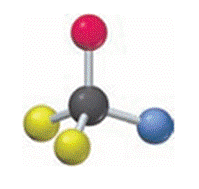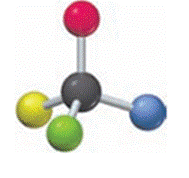
EBK CHEMISTRY
8th Edition
ISBN: 9780135216972
Author: Robinson
Publisher: PEARSON CO
expand_more
expand_more
format_list_bulleted
Concept explainers
Question
Chapter 23, Problem 23.32CP
Interpretation Introduction
(a)
Interpretation:
Whether the molecule is chiral or not needs to be determined.

Concept introduction:
Chiral molecule is a molecule with a tetrahedral central atom and four different substituent groups. This molecule is chiral because in the mirror image the substituent groups have a different geometric arrangement in space.
Interpretation Introduction
(b)
Interpretation:
Whether the given molecule is chiral or not needs to be determined.

Concept introduction:
Chiral molecule is a molecule with a tetrahedral central atom and four different substituent groups. This molecule is chiral because in the mirror image the substituent groups have a different geometric arrangement in space.
Expert Solution & Answer
Want to see the full answer?
Check out a sample textbook solution
Students have asked these similar questions
Draw the most stable cations formed in the mass spectrometer by a deavage of the following compound
Draw the most stable cations formed in the mass spectrometer by a cleavage of the following compound
он
Curved arrows are used to illustrate the flow of electrons. Using the provided starting anand product sytucutrs, draw the curved electron-pusing arrows for the following reaction or mechanistic steps. Be sure to account for all bond-breaking and bind-making steps
Draw the major elimination and substitution products formed in this reavtion. Use a dash or wedge bond to indicatr the stereochemistry of substituents on assymetric centers, wheere applicable. Ignore any inorganic byproducts.
Chapter 23 Solutions
EBK CHEMISTRY
Ch. 23 - Prob. 23.1PCh. 23 - Prob. 23.2ACh. 23 - Prob. 23.3PCh. 23 - Prob. 23.4ACh. 23 - Prob. 23.5PCh. 23 - Prob. 23.6ACh. 23 - Draw a complete electron-dot structure for...Ch. 23 - Limonene is the major component in the oil of...Ch. 23 - Draw an orbital overlap picture for methyl a mine...Ch. 23 - Prob. 23.10A
Ch. 23 - Draw an orbital overlap picture for formaldehyde,...Ch. 23 - Prob. 23.12ACh. 23 - Prob. 23.13PCh. 23 - Prob. 23.14ACh. 23 - Prob. 23.15PCh. 23 - Draw complete electron-dot structures from the...Ch. 23 - Prob. 23.17PCh. 23 - Prob. 23.18ACh. 23 - Draw a simplified orbital overlap picture of...Ch. 23 - Prob. 23.20ACh. 23 - Prob. 23.21PCh. 23 - Prob. 23.22ACh. 23 - Prob. 23.23PCh. 23 - Prob. 23.24ACh. 23 - Prob. 23.25PCh. 23 - Prob. 23.26ACh. 23 - Asparagine is a naturally occurring aminoacid that...Ch. 23 - Prob. 23.28PCh. 23 - Prob. 23.29PCh. 23 - Prob. 23.30CPCh. 23 - Prob. 23.31CPCh. 23 - Prob. 23.32CPCh. 23 - Prob. 23.33CPCh. 23 - Prob. 23.34CPCh. 23 - Prob. 23.35CPCh. 23 - The following structure is a representation of...Ch. 23 - Prob. 23.37CPCh. 23 - Prob. 23.38CPCh. 23 - Prob. 23.39CPCh. 23 - Prob. 23.40SPCh. 23 - Prob. 23.41SPCh. 23 - Draw a straight-chain alkane with 6 carbon atoms...Ch. 23 - Prob. 23.43SPCh. 23 - Prob. 23.44SPCh. 23 - Prob. 23.45SPCh. 23 - The following line drawings represent two amino...Ch. 23 - Prob. 23.47SPCh. 23 - Prob. 23.48SPCh. 23 - Prob. 23.49SPCh. 23 - Prob. 23.50SPCh. 23 - Prob. 23.51SPCh. 23 - Prob. 23.52SPCh. 23 - Prob. 23.53SPCh. 23 - Prob. 23.54SPCh. 23 - Prob. 23.55SPCh. 23 - Prob. 23.56SPCh. 23 - Prob. 23.57SPCh. 23 - Prob. 23.58SPCh. 23 - Give a line drawing and molecular formula for the...Ch. 23 - Prob. 23.60SPCh. 23 - Prob. 23.61SPCh. 23 - Prob. 23.62SPCh. 23 - Prob. 23.63SPCh. 23 - Prob. 23.64SPCh. 23 - Prob. 23.65SPCh. 23 - Draw the complete electron-dot structure and...Ch. 23 - Prob. 23.67SPCh. 23 - Prob. 23.68SPCh. 23 - Prob. 23.69SPCh. 23 - Prob. 23.70SPCh. 23 - Prob. 23.71SPCh. 23 - Prob. 23.72SPCh. 23 - Prob. 23.73SPCh. 23 - Prob. 23.74SPCh. 23 - Prob. 23.75SPCh. 23 - Prob. 23.76SPCh. 23 - Prob. 23.77SPCh. 23 - Prob. 23.78SPCh. 23 - Prob. 23.79SPCh. 23 - Prob. 23.80SPCh. 23 - Prob. 23.81SPCh. 23 - Prob. 23.82SPCh. 23 - Prob. 23.83SPCh. 23 - Prob. 23.84SPCh. 23 - Prob. 23.85SPCh. 23 - Prob. 23.86SPCh. 23 - What does it mean to say that fats and oils are...Ch. 23 - Prob. 23.88SPCh. 23 - Prob. 23.89SPCh. 23 - Prob. 23.90SPCh. 23 - Prob. 23.91SPCh. 23 - Prob. 23.92SPCh. 23 - Prob. 23.93SPCh. 23 - Prob. 23.94SPCh. 23 - Prob. 23.95SPCh. 23 - Prob. 23.96SPCh. 23 - Prob. 23.97SPCh. 23 - Prob. 23.98SPCh. 23 - Prob. 23.99SPCh. 23 - Prob. 23.100SPCh. 23 - Prob. 23.101SPCh. 23 - Prob. 23.102SPCh. 23 - Prob. 23.103SPCh. 23 - Prob. 23.104SPCh. 23 - Prob. 23.105SPCh. 23 - Prob. 23.106SPCh. 23 - Prob. 23.107SPCh. 23 - Prob. 23.108SPCh. 23 - Prob. 23.109SPCh. 23 - Prob. 23.110SPCh. 23 - Prob. 23.111SPCh. 23 - Prob. 23.112SPCh. 23 - Prob. 23.113SPCh. 23 - What amino acids do the following abbreviations...Ch. 23 - Name and draw the structures of amino acids that...Ch. 23 - Identify the amino acids present in the following...Ch. 23 - Prob. 23.117SPCh. 23 - Prob. 23.118SPCh. 23 - Prob. 23.119SPCh. 23 - Prob. 23.120SPCh. 23 - Prob. 23.121SPCh. 23 - Prob. 23.122SPCh. 23 - Prob. 23.123SPCh. 23 - Prob. 23.124SPCh. 23 - Prob. 23.125SPCh. 23 - Prob. 23.126SPCh. 23 - Prob. 23.127SPCh. 23 - Prob. 23.128SPCh. 23 - Prob. 23.129SPCh. 23 - Prob. 23.130SPCh. 23 - Prob. 23.131SPCh. 23 - Prob. 23.132SPCh. 23 - Prob. 23.133SPCh. 23 - Prob. 23.134MPCh. 23 - Prob. 23.135MPCh. 23 - Cytochrome c is an important enzyme found in the...Ch. 23 - Prob. 23.137MPCh. 23 - Prob. 23.138MP
Knowledge Booster
Learn more about
Need a deep-dive on the concept behind this application? Look no further. Learn more about this topic, chemistry and related others by exploring similar questions and additional content below.Similar questions
- Draw the two possible products produced in this E2 elimination. Ignore any inorganic byproductsarrow_forwardDraw the major products of this SN1 reaction. Ignore any inorganic byproducts.arrow_forwardDraw the major elimination and substitution products formed in this reaction. Use a dash or wedge bond to indicate the stereochemistry of substituents on asymmetric centers, wehre applicable. Ignore and inorganic byproducts.arrow_forward
- Curved arrows are used to illustrate the flow of electrons. Using the provided starting and product structures, draw the curved electron-pushing arrows for the following reaction or mechanistic step(s). Be sure to account for all bond-breaking and bond-making steps. Drawing Arrows THE Problem 33 of 35 N. C:0 Na + Submit Drag To Pan +arrow_forwardDraw the product of the E2 reaction shown below. Include the correct stereochemistry. Ignore and inorganic byproducts.arrow_forwardDraw the major producrs of this SN1 reaction. Ignore any inorganic byproducts. Use a dash or wedge bond to indicate the sereochemistry of substituents on asymmetric centers where appllicable.arrow_forward
- 5) Oxaloacetic Acid is an important intermediate in the biosynthesis of citric acid. Synthesize oxaloacetic acid using a mixed Claisen Condensation reaction with two different esters and a sodium ethoxide base. Give your answer as a scheme Hint 1: Your final acid product is producing using a decarboxylation reaction. Hint 2: Look up the structure of oxalic acid. HO all OH oxaloacetic acidarrow_forward20. The Brusselator. This hypothetical system was first proposed by a group work- ing in Brussels [see Prigogine and Lefever (1968)] in connection with spatially nonuniform chemical patterns. Because certain steps involve trimolecular reac tions, it is not a model of any real chemical system but rather a prototype that has been studied extensively. The reaction steps are A-X. B+X-Y+D. 2X+ Y-3X, X-E. 305 It is assumed that concentrations of A, B, D, and E are kept artificially con stant so that only X and Y vary with time. (a) Show that if all rate constants are chosen appropriately, the equations de scribing a Brusselator are: dt A-(B+ 1)x + x²y, dy =Bx-x²y. diarrow_forwardProblem 3. Provide a mechanism for the following transformation: H₂SO A Me. Me Me Me Mearrow_forward
- You are trying to decide if there is a single reagent you can add that will make the following synthesis possible without any other major side products: xi 1. ☑ 2. H₂O хе i Draw the missing reagent X you think will make this synthesis work in the drawing area below. If there is no reagent that will make your desired product in good yield or without complications, just check the box under the drawing area and leave it blank. Click and drag to start drawing a structure. There is no reagent that will make this synthesis work without complications. : ☐ S ☐arrow_forwardPredict the major products of this organic reaction: H OH 1. LiAlH4 2. H₂O ? Note: be sure you use dash and wedge bonds when necessary, for example to distinguish between major products with different stereochemistry. Click and drag to start drawing a structure. G C टेarrow_forwardFor each reaction below, decide if the first stable organic product that forms in solution will create a new C-C bond, and check the appropriate box. Next, for each reaction to which you answered "Yes" to in the table, draw this product in the drawing area below. Note for advanced students: for this problem, don't worry if you think this product will continue to react under the current conditions - just focus on the first stable product you expect to form in solution. NH2 CI MgCl ? Will the first product that forms in this reaction create a new CC bond? Yes No MgBr ? Will the first product that forms in this reaction create a new CC bond? Yes No G टेarrow_forward
arrow_back_ios
SEE MORE QUESTIONS
arrow_forward_ios
Recommended textbooks for you

 Chemistry for Today: General, Organic, and Bioche...ChemistryISBN:9781305960060Author:Spencer L. Seager, Michael R. Slabaugh, Maren S. HansenPublisher:Cengage Learning
Chemistry for Today: General, Organic, and Bioche...ChemistryISBN:9781305960060Author:Spencer L. Seager, Michael R. Slabaugh, Maren S. HansenPublisher:Cengage Learning Chemistry: The Molecular ScienceChemistryISBN:9781285199047Author:John W. Moore, Conrad L. StanitskiPublisher:Cengage Learning
Chemistry: The Molecular ScienceChemistryISBN:9781285199047Author:John W. Moore, Conrad L. StanitskiPublisher:Cengage Learning Chemistry: Principles and PracticeChemistryISBN:9780534420123Author:Daniel L. Reger, Scott R. Goode, David W. Ball, Edward MercerPublisher:Cengage Learning
Chemistry: Principles and PracticeChemistryISBN:9780534420123Author:Daniel L. Reger, Scott R. Goode, David W. Ball, Edward MercerPublisher:Cengage Learning Organic ChemistryChemistryISBN:9781305580350Author:William H. Brown, Brent L. Iverson, Eric Anslyn, Christopher S. FootePublisher:Cengage Learning
Organic ChemistryChemistryISBN:9781305580350Author:William H. Brown, Brent L. Iverson, Eric Anslyn, Christopher S. FootePublisher:Cengage Learning



Chemistry for Today: General, Organic, and Bioche...
Chemistry
ISBN:9781305960060
Author:Spencer L. Seager, Michael R. Slabaugh, Maren S. Hansen
Publisher:Cengage Learning

Chemistry: The Molecular Science
Chemistry
ISBN:9781285199047
Author:John W. Moore, Conrad L. Stanitski
Publisher:Cengage Learning

Chemistry: Principles and Practice
Chemistry
ISBN:9780534420123
Author:Daniel L. Reger, Scott R. Goode, David W. Ball, Edward Mercer
Publisher:Cengage Learning

Organic Chemistry
Chemistry
ISBN:9781305580350
Author:William H. Brown, Brent L. Iverson, Eric Anslyn, Christopher S. Foote
Publisher:Cengage Learning